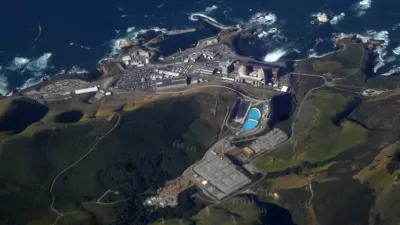A controversial but unanimous vote by California officials last week to keep three older, coastal natural gas power plants operating beyond their termination dates shows that environmental protection takes a back seat to keeping the lights on.

Three aging natural gas power plants power plants in Long Beach (Los Angeles County), Huntington Beach (Orange County), and Oxnard (Ventura County) will remain operational** for three additional years despite the damage they do to the marine environment. These power plants utilize ‘once-through cooling’ that kills “millions of fish, larvae, eggs, seals, sea lions, turtles, and other creatures each year because they are either trapped against screens or drawn into the cooling system and exposed to pressure and high heat,” according to a four-page fact sheet [pdf] written by the California State Water Resources Control Board.
The marine life that is killed is mainly at the base of the food chain, which can adversely affect the future of certain species and impact recreational and commercial fishing.
On August 15, the board voted, once again, to keep these three plants operating to ensure the power grid had sufficient power to avoid rolling blackouts in times of extreme heat. The board had adopted a policy in 2010 to end once-through cooling in order to comply with the federal Clean Water Act.
The vote was “controversial and unanimous,” reported CalMatters' water policy journalist, Rachel Becker. A week earlier the California Energy Commission had also voted to extend the life of all three plants, reported Sophie Austin for The Associated Press on August 10. Austin quoted commissioner Patrick Monahan, who asserted a need for faster adoption of renewable energy, battery storage, and charger buildout, all requiring coordination with energy institutions.
Strategic reliability
“The Newsom administration and the Legislature negotiated a deal last year to improve reliability," wrote POLITICO reporter Wes Venteicher on the August 15 vote by the California State Water Resources Control Board in the source article for this post. “The agreement included extending operations at the nuclear Diablo Canyon Power Plant and creating a new 'strategic reliability reserve' program.”
[Related post: Funding Allocated to Extend Life of Diablo Canyon Nuclear Power Plant (and four natural gas powered plants), July 11, 2022]
“The Department of Water Resources, which is in charge of the reserve program, contracted with the Southern California natural gas plant operators GenOn [Ormond Beach, Oxnard] and AES [Long Beach and Huntington Beach] to keep the plants online at a cost of up to $1.2 billion,” added Venteicher. “The contracts were contingent on the water board’s approval.”
The three facilities are expected to suck in and spit out about 633 billion gallons in the three extension years, killing about 2,400 pounds of fish that get pinned to intake screens and many thousands of other organisms ranging from seals and turtles to larvae, according to a board report.
Ari Plachta, climate reporter for The Sacramento Bee, wrote about Calpine Corporation's two carbon capture and storage projects in northern California on August 5. [Planetizen: Making Natural Gas Power Plants Cleaner.] She also noted that the “Department of Water Resources argued that the strategic reliability reserve of gas plants created by a bill passed by lawmakers at Gov. Gavin Newsom’s urging last summer helped keep the lights on during a punishing September 2022 heat wave.”
- How California Kept the Lights On, September 21, 2022
- Disaster Averted! September 11, 2022
**While the three plants will remain operational, they “will only be used when forecasts project major surges in energy demand,” according to Venteicher of POLITICO.
Hat tip to Streetsblog California's Morning Roundup, August 16.
FULL STORY: California opts for fossil fuels to keep the lights on in extreme heat

Planetizen Federal Action Tracker
A weekly monitor of how Trump’s orders and actions are impacting planners and planning in America.

Congressman Proposes Bill to Rename DC Metro “Trump Train”
The Make Autorail Great Again Act would withhold federal funding to the system until the Washington Metropolitan Area Transit Authority (WMATA), rebrands as the Washington Metropolitan Authority for Greater Access (WMAGA).

DARTSpace Platform Streamlines Dallas TOD Application Process
The Dallas transit agency hopes a shorter permitting timeline will boost transit-oriented development around rail stations.

San Francisco's School District Spent $105M To Build Affordable Housing for Teachers — And That's Just the Beginning
SFUSD joins a growing list of school districts using their land holdings to address housing affordability challenges faced by their own employees.

Car-Centric LA Suburb Looks to a Train-Oriented Future
City leaders in Rancho Cucamonga, the future western terminus of the Brightline West rail line to Las Vegas, want to reimagine the city as a transit-oriented, pedestrian-friendly community.

New Alaska Bitcoin Mine Would Burn as Much Energy as the State’s Largest Coal Plant
Fueled by “stranded” natural gas, the startup hopes to become the largest in the US, and to make Alaska an industry center.
Urban Design for Planners 1: Software Tools
This six-course series explores essential urban design concepts using open source software and equips planners with the tools they need to participate fully in the urban design process.
Planning for Universal Design
Learn the tools for implementing Universal Design in planning regulations.
Municipality of Princeton
Roanoke Valley-Alleghany Regional Commission
City of Mt Shasta
City of Camden Redevelopment Agency
City of Astoria
Transportation Research & Education Center (TREC) at Portland State University
US High Speed Rail Association
City of Camden Redevelopment Agency
Municipality of Princeton (NJ)





























